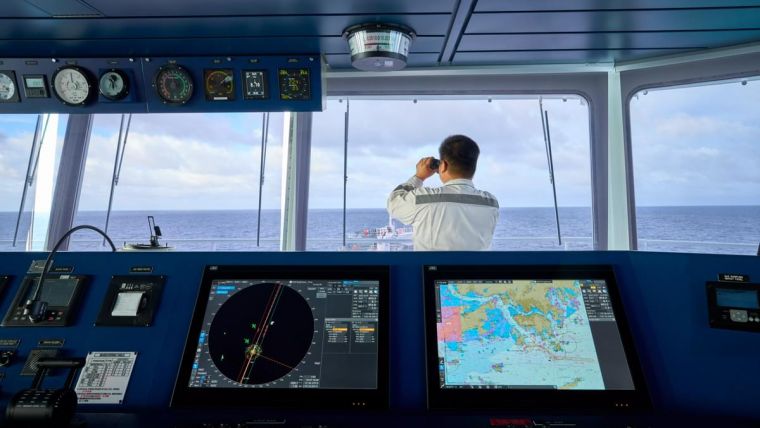Steering shipping towards a sustainable future
How data used primarily for navigation can help decarbonize the maritime industry
Ocean data has a vital but underappreciated role to play as an enabler in shipping’s energy transition. In particular, it can help to unlock the short-term carbon savings that will be essential between now and 2030 to keep the industry on track with its longer-term decarbonization ambitions. From green shipping corridors to just-in-time port arrivals, the UKHO is playing a leading role in several sustainability projects and initiatives that are highlighting the importance of hydrography and marine geospatial information.
Transitioning away from fossil fuels to more sustainable energy sources is the biggest challenge facing shipping, an industry that accounts for 3% of global emissions annually and transports 90% of the world’s goods. Several measures to help achieve this goal have been earmarked, including alternative fuels, more energy-efficient vessels and digital technologies. However, the conundrum facing shipping’s decision makers is how to turn these ideas into reality. One underappreciated asset in this fight is ocean data. This data, which is primarily used for navigational purposes, can help steer shipping towards a more sustainable future. What’s more, it can deliver the short-term carbon savings that are urgently required by shipping – and the planet.
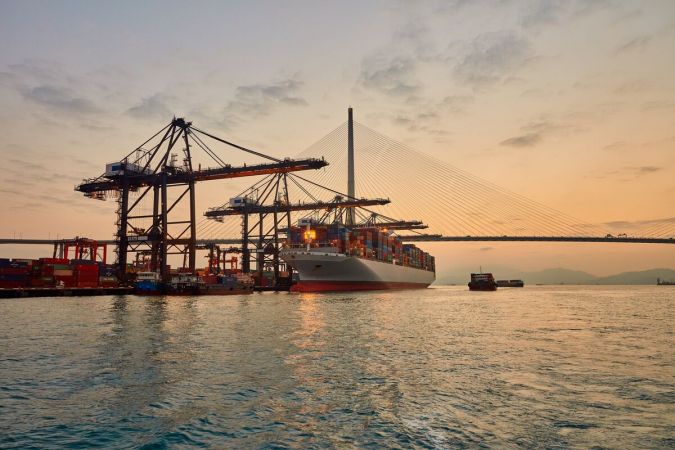
Data has long been integral to powering the navigational tools that support safe, compliant ship operations. It now has a major role to play in maritime’s energy transition, which promises to radically transform the sector’s vessels, voyages, fuels, routes and trades. Marine geospatial data is significant because it can provide owners and mariners with an authoritative view of the world around them. Previously, this view has been mainly focused on hazards, depths and other issues associated with navigating in the marine environment. Today, that same information can be used to ensure just-in-time arrivals, underpin the effectiveness and safety of green shipping corridors and support voyage optimization, turning the view of the world around them into an actionable foundation for better decision-making.
The potential impact of these initiatives is significant. For example, just-in-time arrivals, which would be partly powered by navigational data in a more connected marine data ecosystem, could unlock an 11% fuel and emissions saving for shipping in the near term, according to the International Maritime Organization (IMO).
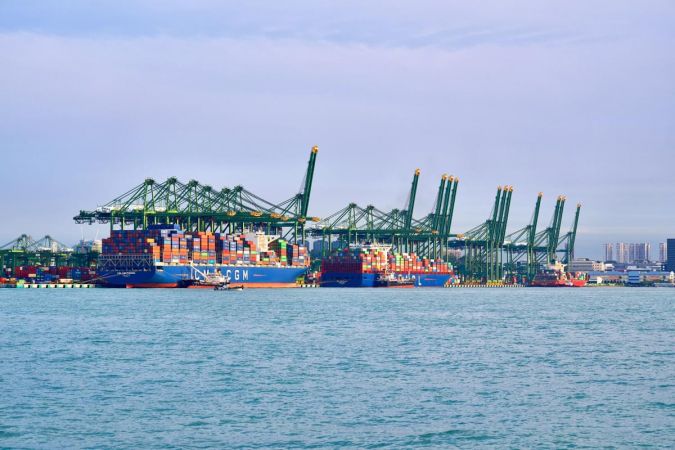
Voyage optimization
Advancements in ship design, fuel efficiency innovations and voyage optimization techniques are already having a tangible positive impact. However, these initiatives alone will not completely decarbonize the shipping industry. To enable the transition towards voyage optimization, reliable and timely data is critical. In support of the collaborative effort to reduce fuel consumption and emissions, shipowners and mariners need the latest information to be able to effectively monitor their activities, optimize their performance and make informed decisions. To this end, high-quality, interoperable and standardized data will be key.
The next generation of navigational data products, underpinned by the International Hydrographic Organization’s S-100 data standards, can play a major role in supporting the industry’s decarbonization ambitions. The data standards provide a set of guidelines that define how nautical information is structured, encoded and exchanged between systems. They are intended to provide a common framework for the exchange of marine data, making it easier for organizations to share a wide range of information types, including nautical charts, bathymetric data, surface currents, water levels and more.
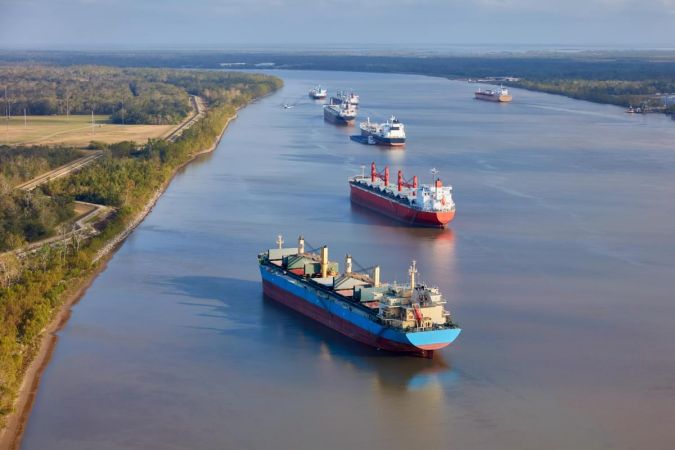
Armed with more granular and timely data on the ocean environment and its conditions, this will provide the basis for more efficient decisions around navigation, cargo loading and entering or leaving ports. The resulting operational efficiencies can not only provide economic benefit for shipping companies, but crucially can help to reduce emissions through innovative measures such as just-in-time arrivals.
Just-in-time arrivals
The current process of making a port call is inefficient, with ships rushing to their destination only to find that they cannot dock for various reasons, such as another vessel occupying the berth or cargo not being available. This results in ships having to idle outside the port for long periods or move exceedingly slowly while waiting for the availability of the necessary services.
Adopting the just-in-time arrivals approach could yield significant benefits, such as improved safety, reduced emissions, cost savings and better planning capacity. Just-in-time arrivals would enable a ship to adjust and optimize its speed during its voyage, reducing greenhouse gas emissions from sailing faster than required and from potentially waiting to enter port – reducing the environmental and economic inefficiencies of ‘sail fast then wait’.
Green shipping corridors
Green shipping corridors – a route between two or more ports where zero-emission shipping solutions are demonstrated and reported – have been identified as a key component to achieving a target of 5% of vessels operating on zero-emission fuels by 2030. With the sector emitting around 3% of all global greenhouse emissions, accounting for up to one billion metric tonnes of CO2 emissions annually, intervention is critical to reduce maritime’s carbon footprint – and to keep the industry on the right trajectory to achieve the IMO’s target of cutting emissions at least in half by 2050.
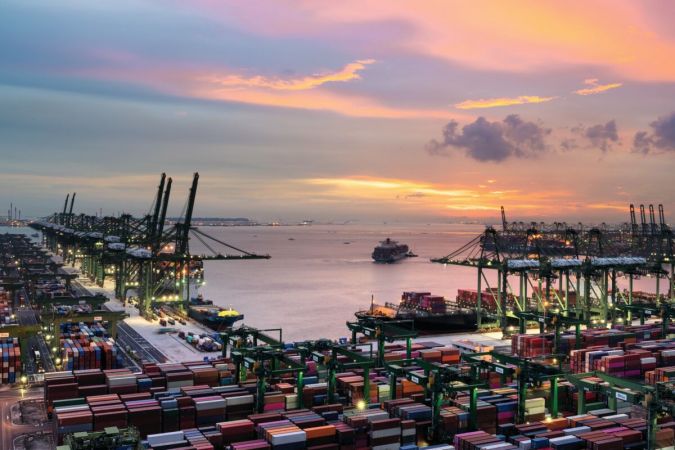
The catalyst for driving change is to create an environment that facilitates cross-sector partnerships, helping to drive policy change, generate innovation and stimulate the next phase of developments. However, private operators and public authorities are likely to find it difficult and costly to deviate from today’s norm. Therefore, collaboration is needed between all stakeholders across the entire shipping value chain for this to be achieved. These stakeholders include governments and regulatory authorities, port and ship operators, freight companies, fuel producers, cargo owners and local communities living near or around ports. Their input is necessary to develop new regulations, contracts, policies and facilities to enable the safe operation of green fuels.
A green corridor, which can operate domestically, short-sea or across continents and multiple ports, is a carefully designed ecosystem of change factors, similar to a special economic zone. These factors include port and ship technology, fuel usage and voyage optimization. Building such a corridor requires the advancement of technological, commercial or regulatory initiatives along the route. To succeed, green routes are optimized through the combined efforts of private operators and public authorities. Public investment, extension of fossil fuel subsidies to zero-emission fuels and targeted policies that introduce best practice guidelines all help incentivize the adoption of new technologies and our shared decarbonization goals.
Green shipping corridors will be key to helping decarbonize the shipping industry, bringing benefits to a wide range of stakeholders, from ship and port operators to consumers and local communities. These include crucial environmental benefits such as increased biodiversity and a cleaner marine environment, as well as economic savings from reduced running costs and shorter anchorage times. These benefits can be achieved by using technology and automation.
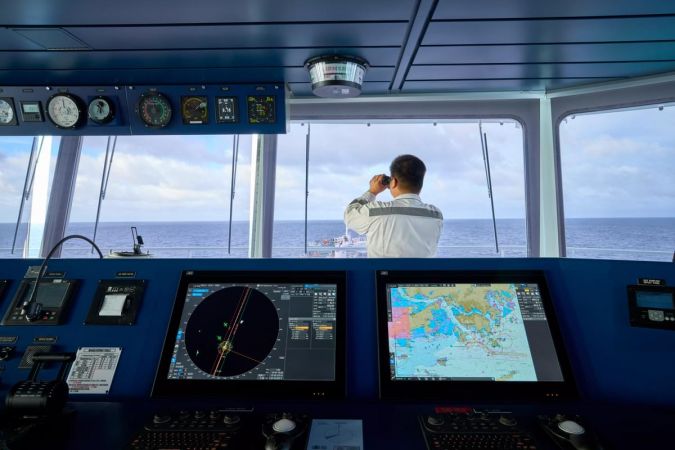
UKHO-supported sustainability initiatives
Shifting to sustainable shipping will require collaboration between governments, companies, technology providers and other stakeholders to ensure that we can continue to trade globally while minimizing the impact on the environment.
The UKHO has several workstreams focused on unlocking the power of marine geospatial data to contribute to maritime decarbonization. It supports the UK government’s work on the concept of green shipping corridors, is advancing the development of just-in-time arrivals via multilateral industry coalitions, and is a partner in the exciting ‘Blue Visby’ project.
Blue Visby Solution
The Blue Visby Solution (BVS) aims to address the ‘sail fast then wait’ approach by introducing a far more efficient queuing system for ships bound to the same destination port. This system involves synchronizing and optimizing the ocean passages of a group of vessels, allocating optimized arrival times and ensuring an arrival frequency that the port can handle. The project is operated by a consortium of companies and organizations that work together to test and refine the solution. As a consortium member, the UKHO has contributed to the BVS by conceptualizing the Blue Visby ‘Blue Box’ – a feature determining the start and end point of an optimized BVS.
Using its marine geospatial data and expertise, the UKHO has helped develop a proof-of-concept methodology to understand how these Blue Boxes could be identified and charted. This would enable a vessel to approach a port from any direction, rather than specifically having to plan a route through a specified Blue Box, reducing risk to crew and vessels.
Global Maritime Forum
The Global Maritime Forum (GMF) is an international not-for-profit organization committed to shaping the future of global seaborne trade to increase sustainable long-term economic development and human well-being. The forum brings together leaders from all parts of the maritime industry, from regulators and policymakers to intergovernmental institutions and academia, to address the most important issues that the industry is facing.
As a knowledge partner on the GMF Short-Term Actions Taskforce, the UKHO offers its hydrographic expertise to contribute to key research and insight pieces that will help unlock the potential of operational efficiencies and the fuel and carbon savings that come with them.
Smart Maritime Network
The Smart Maritime Network (SMN) provides a platform to share data and improve collaboration among stakeholders in the maritime and transport logistics sectors. This is achieved through the sharing of key industry news, interviews, white papers, presentations and conferences on maritime innovation.
The UKHO is a member of the Smart Maritime Council, which brings together representatives from a range of companies to build partnerships and discuss issues related to compatibility, standardization and harmonization. UKHO representatives regularly meet with other industry stakeholders within the SMN to offer expertise on hydrography, maritime navigation and data sharing to help achieve the network’s shared goals.
With a growing number of sustainability projects and initiatives supported by geospatial data underway and making tangible progress, there is room for optimism about making shipping cleaner and greener in the coming years. Marine geospatial data has a fundamental role to play, both in achieving shipping’s short-term carbon savings and in keeping us on track for shipping’s longer-term energy transition. But the momentum must continue, with stakeholders across the sector having to play their part to reduce maritime’s carbon footprint in line with the IMO’s decarbonization goals. Steering shipping towards a more sustainable future is possible, providing we adopt a collaborative approach with engagement from all.
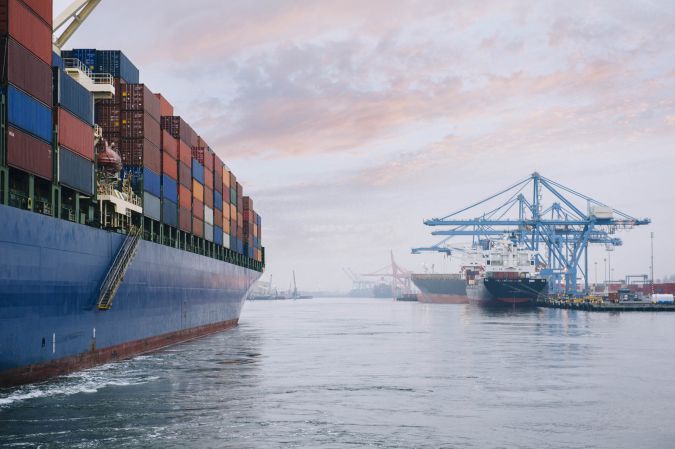

Value staying current with hydrography?
Stay on the map with our expertly curated newsletters.
We provide educational insights, industry updates, and inspiring stories from the world of hydrography to help you learn, grow, and navigate your field with confidence. Don't miss out - subscribe today and ensure you're always informed, educated, and inspired by the latest in hydrographic technology and research.
Choose your newsletter(s)
